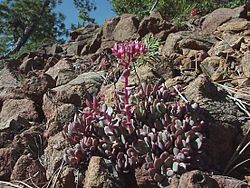Top Qs
Timeline
Chat
Perspective
Sedum eastwoodiae
Species of plant in the family Crassulaceae From Wikipedia, the free encyclopedia
Remove ads
Sedum eastwoodiae is a rare species of flowering plant of the stonecrop Crassulaceae family.[2] It is known by its common name Red Mountain stonecrop. It is endemic to Mendocino County, California, where it is known from only four occurrences on Red Mountain, near Ukiah.[1][3] The total number of plants in existence is estimated to be around 5,300.[1] They can be found on steep, exposed, rocky mountain slopes of serpentine substrate. This species has also been treated as a subspecies of Sedum laxum.[4]
Remove ads
Description
Sedum eastwoodiae is a small perennial succulent plant forming basal rosettes a few centimeters wide. The leaves are 1 to 3 centimeters long with the widest part near the distal end, then narrowing to a rounded or slightly notched tip. Smaller leaves occur higher up the stem. The foliage is blue-green in color, blushing reddish. The inflorescence is a spreading or flat-topped array of many small, star-shaped flowers with red or pink petals up to a centimeter long each, and stamens with red or purplish anthers.
Remove ads
Habitat
This species is known from a small section of habitat on a single mountain where the main potential threat to its existence is mining for nickel, chromium, and cobalt.[4]
References
External links
Wikiwand - on
Seamless Wikipedia browsing. On steroids.
Remove ads


